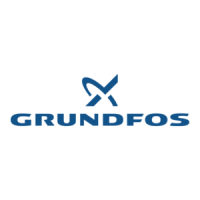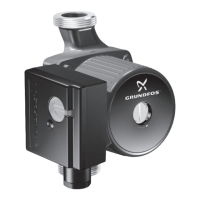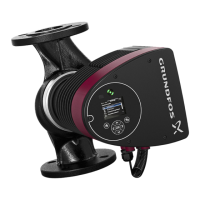10
4.3 Impeller diameter
At the customer’s request, the impeller diameter may have been
changed to allow the pump to match a specified duty point. This
means that the actual impeller diameter differs from the standard
diameters stated in sales catalogues, data sheets, etc.
The actual impeller diameter can be found on the pump
nameplate.
4.4 Pumped liquids
Clean, thin, non-explosive liquids without solid particles or fibres.
The pumped liquid must not attack the pump materials
chemically.
When pumping liquids with a density and/or viscosity higher than
that of water, motors with correspondingly higher outputs must be
used, if required.
O-rings and the mechanical shaft seal chosen must be suitable
for the liquid to be pumped.
Special shaft seals may be required if the pump is used for
pumping treated water at temperatures above 80 °C containing
additives to prevent system corrosion, calcareous deposits, etc.,
for instance in heating and ventilating systems.
Another type of shaft seal may also be required for the pumping
of glycol-containing liquids.
For heating systems, the water quality should meet VDI 2035.
Contact Grundfos for further information.
5. Technical data
5.1 Ambient temperature
The ambient temperature and the installation altitude are
important factors for the motor life, as they affect the life of the
bearings and insulation system.
Maximum ambient temperature:
• EFF2 motors: +40 °C.
• EFF1 motors: +60 °C.
If the ambient temperature exceeds +40 °C (+60 °C), or the motor
is installed more than 1000 m (3500 m) above sea level, the
motor must not be fully loaded due to the low density and
consequently low cooling effect of the air. In such cases, it may
be necessary to use a motor with a higher output.
Fig. 6 Motor P2 in relation to temperature/altitude
5.2 Liquid temperature
–25 °C to +140 °C.
The maximum liquid temperature is stated on the pump
nameplate. It depends on the shaft seal chosen.
For pump housing of cast iron EN-GJL-250 local regulations may
not allow liquid temperatures above +120 °C.
5.3 Operating pressure
The maximum operating pressure is stated on the nameplate.
NB:
Maximum 1.6 MPa (16 bar).
DN 200: 1 MPa (10 bar).
NBG:
Maximum 1.6 MPa (16 bar).
5.4 Min. inlet pressure
According to the NPSH curve of the pump (see page 599)
+ a safety margin of minimum 0.5 m head.
The procedure for the calculation of the minimum inlet pressure is
shown in 14. Calculation of minimum inlet pressure.
5.5 Maximum inlet pressure
The actual inlet pressure + pressure when the pump is running
against a closed valve must always be lower than the maximum
operating pressure.
5.6 Minimum flow rate
The minimum flow rate must be at least 10 % of the maximum
flow rate. The flow rate and head are stated on the pump
nameplate.
5.7 Maximum flow rate
The maximum flow rate must not exceed the values stated for the
individual pump on page 585, as otherwise there is a risk of for
instance cavitation and overload.
5.8 Electrical data
See the motor nameplate.
5.9 Weight
See label on the packing.
5.10 Sound level
See table on page 583.
The values stated are maximum values, including the upper
tolerance of 3 dB according to ISO 4871.
5.11 Pump speed relative to material and size
Fig. 7 Maximum permissible speed
For stainless steel pumps (1.4408/1.4517) or cast iron pumps
with stainless steel impellers there is no limit in the range shown.
TM02 8551 0504
20 25 30 35 40 45 50 55 60 65 70 75 80
50
60
70
80
90
100
[%]
P2
EFF 2
EFF 1
t [°C]
1000 2250 3500 4750 m
TM03 4109 1806
1200 1600 2000 2400 2800 3200 3 600
min
-1
200
250
300
350
400
450
500
550
600
650
CuSn10
EN-GJL-200
Ø [mm]

